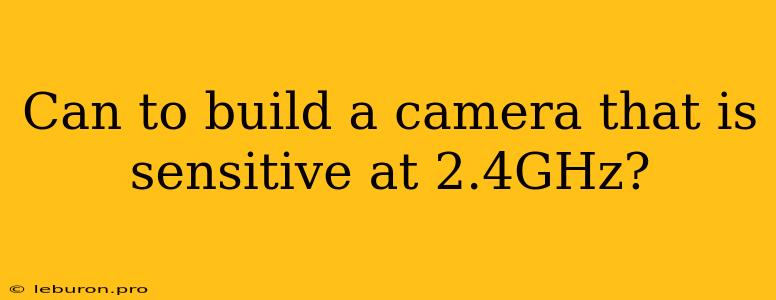The realm of imaging technology is constantly evolving, pushing the boundaries of what we can see and how we perceive the world around us. From the humble beginnings of film cameras to the advanced digital sensors of today, the pursuit of capturing light has led to remarkable innovations. A particularly intriguing question arises: Can we build a camera that is sensitive at 2.4 GHz? This question delves into the realm of electromagnetic radiation and the limitations of conventional camera technology. To answer this, we must explore the fundamentals of light, cameras, and the specific properties of the 2.4 GHz frequency.
Understanding the Nature of Light and Cameras
Light, in its broadest sense, encompasses the entire electromagnetic spectrum, a vast range of radiation spanning from low-energy radio waves to high-energy gamma rays. Visible light, the portion we can perceive with our eyes, occupies a narrow band within this spectrum. Cameras, in their traditional form, are designed to capture this visible light. They employ lenses to focus the incoming light onto a light-sensitive sensor, which converts the light into an electrical signal that can be processed to create an image.
The Challenge of 2.4 GHz Detection
The 2.4 GHz frequency falls within the microwave portion of the electromagnetic spectrum, far beyond the range of visible light. This presents a significant challenge for conventional camera technology. Conventional cameras, designed to detect visible light, are fundamentally incapable of directly sensing microwaves. The fundamental principles behind camera operation, relying on the interaction of photons with a sensor, do not apply to microwaves.
Exploring Alternative Approaches
While directly capturing 2.4 GHz radiation with a traditional camera is not feasible, alternative approaches exist. These methods involve harnessing the principles of microwave detection and image formation:
1. Microwave Imaging Techniques
Microwave imaging, a field distinct from conventional optical imaging, utilizes microwaves to create images. It relies on the interaction of microwaves with objects, where the reflected or transmitted waves provide information about the object's properties. Techniques like microwave radar, used in applications like weather forecasting and self-driving cars, rely on the principles of microwave imaging.
However, building a "camera" that directly captures 2.4 GHz signals for visualization presents technical challenges. The wavelengths of 2.4 GHz radiation are significantly longer than visible light, making it difficult to achieve the spatial resolution required for detailed imaging. Moreover, the energy levels associated with microwaves are relatively low, requiring sensitive detectors and amplification techniques.
2. Heterodyne Detection and Frequency Conversion
Heterodyne detection is a technique commonly used in radio astronomy and other applications to detect weak signals. It involves mixing the incoming signal with a locally generated signal (local oscillator) to produce a beat frequency, which is then amplified and processed. This approach can be adapted for detecting and visualizing 2.4 GHz signals.
However, the process of converting the 2.4 GHz signal to a visible frequency range would require specialized components and techniques. The accuracy of conversion and the resulting image resolution depend on the design and capabilities of the frequency conversion system.
Conclusion
While the question of building a camera that is sensitive at 2.4 GHz remains a significant challenge, ongoing research and technological advancements offer potential solutions. Utilizing microwave imaging techniques or adapting heterodyne detection principles could pave the way for new imaging technologies capable of capturing and visualizing microwave radiation. However, overcoming the limitations of wavelength, energy levels, and signal processing remains a significant hurdle. Despite the complexities, the potential applications of such technology are vast, spanning fields like medical imaging, security, and communications. As our understanding of the electromagnetic spectrum and its interactions with matter continues to evolve, the possibility of creating a camera sensitive at 2.4 GHz, or even higher frequencies, may become a reality.
